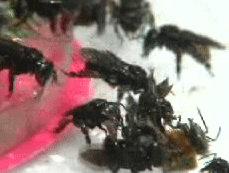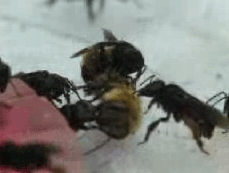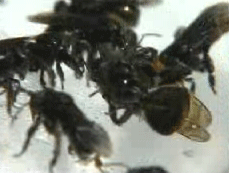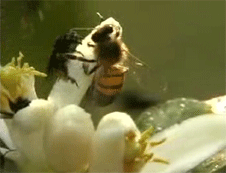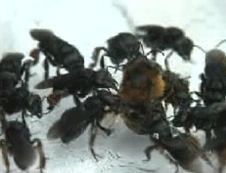|
Analysis of Stingless Bee Aggression By
Dylan Voeller and James Nieh
(T.
spinipes forager attacking M.
rufiventris forager at a food source) I. Principles introduced in this
exercise A. Aggression: how they
attack B. Defender's
perspective: what to attack C. Results of aggression II. Introduction The social
regulation of aggression plays an important role in competitive interactions
among animals ( Moynihan 1998 ); the structure of arthropod
communities ( Reitz and Trumble 2002 ); invasion ecology ( Holway et al. 2002 ); and the evolution of animal
behavior ( Maynard-Smith and Harper 1988 ). However,
questions remain concerning the detailed effects of group size on individual aggression during
aggressive encounters between groups ( Archer 1988 ), even in primates ( Bernstein and Ehardt 1985; Camperio 1986;
Goodall 1990; Stanford et al. 1994; Gros-Louis et al. 2003 ). In social insects,
group aggression plays a vital role in ants, social bees, and social wasps
during nest defense and, in some species, during foraging ( Wilson 1971; Michener 1974; Breed et al. 1990;
Hölldobler and Wilson 1990 ). For example, Wilson ( 1971 ) reported that individual Ancanthomyops claviger ants increased their sensitivity to alarm
odors when in larger groups. Interspecific
competition over limited food sources has led to the evolution of aggressive
group recruitment systems in stingless bees (Hymenoptera, Apidae,
Meliponini), one of the most important native
Neotropical pollinators ( Johnson and Hubbell 1974; Johnson
and Hubbell 1987; Roubik 1989; Nagamitsu and Inoue 1997; Slaa et al. 1997;
Kevan and Imperatriz-Fonseca 2002; Slaa 2003; Nieh et al. 2004 ). Such aggressive competition may be costly and
critical to colony survival, especially during periods of relative food
dearth ( Roubik 1982; Roubik 1989 ). Johnson & Hubbell ( 1974 ) recorded 63% mortality (1812 dead bees) after
a two-day battle between three colonies of T. corvina ( Lepeletier 1835 ) over sucrose solution baits. However, relatively
little is known about the detailed patterns of aggressive behavior ( Johnson 1974 ) that constitute meliponine dominance styles,
or the strategies and behaviors that individuals or groups typically employ
to attain dominance ( Cooper and Bernstein 2002 ). This
exercise focuses on defining behaviors involved in aggressive encounters
between bee species in order to better understand these interactions. III.
Materials
& Methods We are going to look at
several movies which show bees battling over a food source: a sugar solution feeder
(pink platform) or a flower. The T. spinipes foragers are the smaller,
more numerous black bees and the victim is a species of Melipona, in these videos the larger furry bee. Unlike honeybees, stingless bees do not
have stingers so they fight with their jaws (mandibles).
A.
Click on the
link titled “T. hyalinata vs. M. rufiventris” to open the Quicktime
movie. Once the file has opened and
begins to play, count the number of bees attacking the victim. If the bees are moving too fast, first
watch the video in real time, and then watch it frame-by-frame.
1. Click on the pause button
2. Click on the forward or back button The Aggressor B.
*Choose one of
the black bees (T. spinipes) and
determine her attack intensity throughout the video. Define the attack intensity using the
following table. Level I: low
intensity threats (facing opponent and wide wingspread) without direct
contact Level II: brief body contact (for example, a quick bite) Level III: extended biting and pulling Level IV: wrestling (individuals are locked together by
leg gripping and/or mandible contact) Escape: attempting to walk or fly away while being
restricted from moving away by attackers *Definitions based on Johnson & Hubbell (1974), and
Nieh et al. (2005). Here is an example of a
sample table you could draw up. Each
student can fill in a different column of the table. Sample Table 1: Aggression
classifications from T. hyalinata
vs. M. rufiventris
C.
Does the
attack intensity of your bee change?
Does it increase or decrease?
If it does change, then make a new table showing that change at two
different points in time. For example,
create a “beginning” table and an “end” table. Sample Table 2: Aggression
classifications from T. hyalinata
vs. M. rufiventris BEGINNING
Sample Table 3: Aggression classifications from T. hyalinata vs. M. rufiventris END
The Victim D.
Define the
region of the body being targeted by each attacker as either “head” or
“thorax and abdomen”. E. Repeat steps A though D for the remaining Quicktime movies. The Attack Strategy Stingless
bees, like honeybees, have certain attack preferences. Stingless bees like to attack hairy objects
and dark objects. If you think about
this, you will realize that bees are drawn towards attacking sensitive areas
around the head of a predator. When
they attack each other stingless bees can try to cut off wings, legs, or even
the head. In fact, you can sometimes
see bees flying around with their legs “decorated” with the severed heads of
unsuccessful attackers. This happens
during group attacks when members of the colony defend the bee being
attacked. F.
Can you
describe what kind of attack strategy you saw in each of the three videos? G.
How did the
victim respond? Since there was only a
single victim and several attackers, what would be the best strategy for the
victim? H.
If the victim
is trying to escape and the attackers want to prevent this, are there any
strategies that the attackers should use? IV.
Sample
Results In
the T. hyalinata vs. M. rufiventris video we observed: *Note the positions of the play bar which tell you
where the aggression occurred in the video
Level I aggression (A T.
hyalinata forager spreads its wings while moving towards the M. rufiventris victim)
Level II aggression (A T.
hyalinata forager executes a quick bite as the M. rufiventris forager tries to run away)
Level III aggression (A T.
hyalinata forager remains on M.
rufiventris while biting for several seconds)
Level IV aggression (A T. hyalinata
forager and M. rufiventris victim
wrestle with locked mandibles for an extended period of time)
Escape (M.
rufiventris attempts to run away while several T. hyalinata foragers follow behind) V. Sample Discussion Questions A.
How did
the bees attack? B.
Was there
anything in particular that attackers focused on? C.
Why might
some body parts be attacked over others? D.
What were
the results of the aggression? Did the
attacker run away? E.
What does
it mean to have a higher level of aggression? F.
What kinds
of animals do you think this kind of attack would be effective on? G.
Have you
ever seen a bee attack before or been attacked? H.
How do you
think the bees evolved their particular strategy of attacks? VI. Sample Conclusions A group of T. spinipes bees (attackers) dominated
a single larger Melipona sp. bee (attackee) in each movie. It appears that the use of aggression by
the T. spinipes bees in larger
numbers may be an effective strategy for warding off the larger Melipona sp. bees. It is possible
that this aggression strategy could have evolved because attacking in groups
allowed the smaller bees to win more “battles” and therefore gain access to
more food resources. It is also
possible that attacking in groups decreases the chances of injury for the
smaller bees, as escalated aggression levels are more likely to lead to
serious injury. The attackers did not
seem to focus on any one part of the body more often than the other, but
there was almost always more than one bee attacking at any one time. References Archer, J., 1988. The behavioural biology of aggression.
257. Bernstein, I.S., 1981.
Dominance: the baby and the bathwater. Behavioral
and Brain Sciences 4: 419-457. Breed, M.D., Robinson,
G.E., and Page Jr., R.E., 1990. Division of labor during honey bee colony
defense. Behavioral Ecology and
Sociobiology 27: 395-401. in
town and forest areas in Cooper, M.A.,
Bernstein, I.S., 2002. Counter aggression and reconciliation in Assamese macaques
(Macaca assamensis). American Journal of Primatology 56:
215-230. Goodall, J., 1990. Through a window: thirty years with the
chimpanzees of Gombe. Weidenfield
& Nicholson, 288. Gros-Louis, J., Perry,
S., and Manson, J.H., 2003. Violent coalitionary attacks and intraspecific
killing in wild white-faced capuchin monkeys (Cebus capucinus). Primates 44: 341-346. Hölldobler, B., and of
Holway, D.A., Lach, L.,
Suarez, A.V., consequences
of ant invasions. Annual Review of
Ecology and Systematics 33: 181-233. Johnson, L.K., 1974.
The role of agonistic behavior in the foraging strategies of Trigona bees. Johnson, L.K. and
Hubbell, S.P., 1974. Aggression and competition among stingless bees: field
studies. Ecology 55: 120-127. Johnson, L.K., and
Hubbell, S.P., 1987. Defense of a food supply by eusocial colonies. American Zoologist 27: 347-358. Kevan, P.G., and
Imperatriz-Fonseca, V.L., 2002. Pollinating
bees: the conservation link between agriculture and nature. Proceedings of the workshop on the
conservation and sustainable
use of pollinators in agriculture, with emphasis on bees, Lepeletier, S.-F.D.,
1835. Histoire naturelle
d’insectes-hyménoptéres. Paris, Roret, 1-547. Maynard-Smith, J. and
Harper, D.G.C., 1988. The evolution of aggression: can selection generate
variability? Philosophical Transactions
of the Royal Society of Biological Sciences 319: 557-570. Michener, C.D., 1974. The social behavior of the bees. Press. Moynihan, M., 1998. The social regulation of competition and
aggression in animals. Smithsonian
Institution Press, 158. Nagamitsu, T., and
Inoue, T., 1997. Aggressive foraging of social bees as a mechanism of floral
resource partitioning in an Asian tropical rainforest. Oecologia 110: 432-439. Nieh, J.C., Barreto,
L.S., Contrera, F.A.L., and Imperatriz-Fonseca, V.L., 2004. Olfactory eavesdropping
by a competitively foraging stingless bee, Trigona spinipes. Proceedings of the Royal Society of Nieh, J.C., Kruizinga, K.,
Barreto, L.S., Contrera, F.A.L., and Imperatriz-Fonseca, V.L., 2005.
Effect of group size on the aggression strategy of an extirpating stingless
bee, Trigona spinipes. Insectes
Sociaux, in press. Reitz, S.R. and
Trumble, J.T., 2002. Competative displacement among insects and arachnids. Annual Review of Entomology 47, 435-465. Roubik, D.W., 1982.
Seasonality in colony food storage, brood production, and adult survivorship:
studies of Melipona in tropical
forest (Hyminoptera: Apidae). Journal of the Roubik, D.W., 1989. Ecology and natural history of tropical
bees. University
Press, 514. Slaa, E.J., 2003.
Foraging ecology of stingless bees: from individual behaviour to community ecology.
PhD thesis, Department of Behavioural
Biology. Slaa, E.J., van Nieuwstadt, M.G.L., of
stingless bees (Apidae Meliponinae):
the relation between precision recruitment, competition
and communication. Acta Horticulturae
437: 193-197. Stanford, C.B., Wallis,
J.B., Matama, H., and Goodall, J., 1994. Patterns of predation by chimpanzees
on red colobus monkeys in Physical Anthropology 94: 213-228. Press,
548. |

